For many travelers, the convenience of withdrawing money from an ATM or swiping a credit card is something they take for granted. But in some remote corners of the world, banking infrastructure is virtually nonexistent. Traveling in cash-only economies presents a unique set of challenges and requires careful planning, adaptability, and resourcefulness.
The Reality of a Cash-Only Economy
Some regions, particularly remote islands, rural villages, or politically isolated nations, operate almost entirely on cash. There are no ATMs to withdraw money, no card readers in shops, and no banks to exchange currency. In these areas, people rely on barter, informal lending, or simply physical cash for all transactions.
Preparing for a Cash-Only Trip
Before setting foot in a destination with no banking infrastructure, preparation is key. Travelers must ensure they bring enough cash to cover their entire stay, plus a buffer for emergencies. Researching the local currency, exchange rates, and availability of money changers is crucial. Carrying small denominations is also recommended, as large bills might not be accepted or easily broken.
Challenges of Managing Cash
One of the biggest hurdles in a cash-only destination is keeping money safe. Without the ability to rely on digital payments, travelers must be extra cautious about theft or loss. Strategies such as distributing cash across multiple hiding places, using money belts, and carrying a decoy wallet can add layers of security.
Alternative Payment Methods
In some regions, alternative payment methods exist even when banks don’t. Bartering services or goods can sometimes be an option, particularly in close-knit communities where personal trust matters more than money. Some places have local scrip or informal credit systems where residents keep track of debts and settle them later. Mobile payment apps may also be available in unexpected places, allowing digital transactions even without traditional banking.
The Social Aspect of a Cash-Based Society
Without banks and digital transactions, financial interactions often become more personal. Buying something at a local market may involve negotiating directly with the seller. Restaurants may run on a trust system where patrons pay later if they don’t have exact change. In many ways, this fosters a sense of community and closer human connections, something lost in modern cashless societies.
The Unexpected Benefits
Despite the difficulties, traveling in a cash-only economy offers a unique perspective. It forces travelers to be mindful of their spending, engage more with locals, and experience a different way of life. It also serves as a reminder of how much of the world still operates outside of modern banking systems.
Traveling in a place without ATMs, credit cards, or banks is a challenge, but it’s also an adventure. With proper planning and an open mind, it’s possible to navigate these economies while gaining a deeper appreciation for different financial systems. Whether it’s through careful budgeting, bartering, or relying on the generosity of locals, surviving in a cash-only world is an experience that tests and strengthens a traveler’s adaptability.

